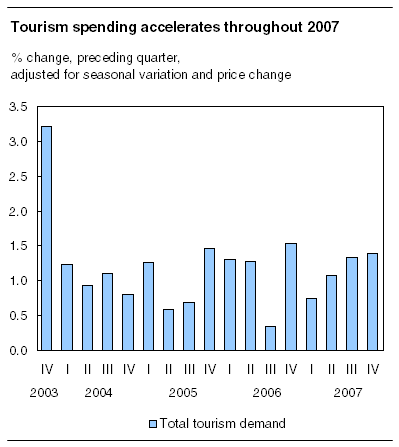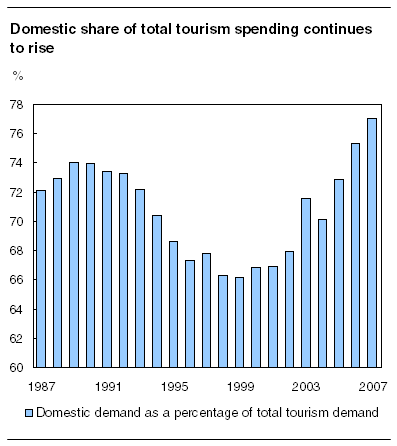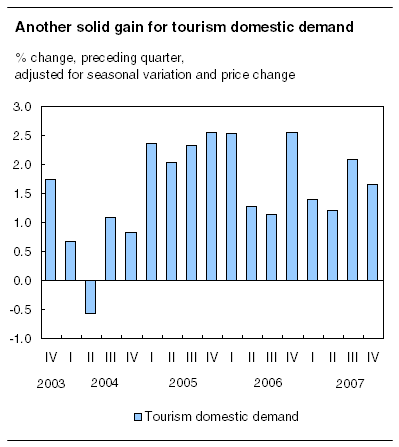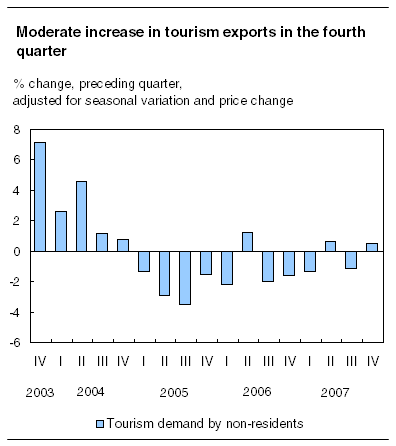Common menu bar links
National tourism indicators
Archived Content
Information identified as archived is provided for reference, research or recordkeeping purposes. It is not subject to the Government of Canada Web Standards and has not been altered or updated since it was archived. Please "contact us" to request a format other than those available.

Tourism spending advanced 1.4% in the fourth quarter of 2007 as outlays by both Canadians and non-residents visiting Canada increased. This was the fastest quarterly pace set in 2007, bringing the growth in tourism expenditures to 4.3% for the year.

This was also the 18th consecutive quarterly increase in tourism demand since the second quarter of 2003, when tourism was hit hard by the severe acute respiratory syndrome (SARS), and the fourth annual gain since 2003.
Tourism spending reached $70.6 billion at current prices in 2007, with Canadians accounting for nearly four out of every five dollars (77%). This share was up notably from the end of the 1990s, when Canadians accounted for only two out of every three tourism dollars (66%).
Canadians' tourism spending continues up
Spending by Canadians on tourism in Canada advanced 1.6% in the fourth quarter of 2007, bringing growth for the year to 6.7%. Low unemployment and interest rates coupled with strong gains in disposable income contributed to the solid performance in 2007. The pace of growth was not as robust as in 2006, however, when tourism domestic demand advanced 8.5%.
Note to readersLevels and shares of tourism spending are expressed in current dollars, adjusted for seasonal variations. Growth rates of tourism spending and gross domestic product are expressed in real terms (i.e., adjusted for price change) as well as adjusted for seasonal variations, unless otherwise indicated. Employment data are also seasonally adjusted. Associated percentage changes are presented at quarterly rates. The National Tourism Indicators are funded by the Canadian Tourism Commission. |
Canadians increased their travel outside Canada during the fourth quarter, as the number of outbound trips jumped 9.0%, the strongest quarterly gain in 16 years. The international travel deficit rose $785 million to $3.6 billion, breaking the record set one quarter earlier. A deficit indicates that Canadian travellers spend more outside Canada than international travellers spend in Canada.

A strong 3.0% hike in domestic spending on airfares reflected both the increase in Canadians' travel abroad and domestic travel. (In the National Tourism Indicators, Canadians' spending on international transportation with Canadian carriers is counted as spending in Canada and is thus included in tourism domestic demand.) For 2007 as a whole, tourism spending by Canadians on air transportation increased 10%, the fourth consecutive year of solid gains.
International tourism spending boosted by overnight stays
International tourism spending (tourism exports) edged up 0.5% during the fourth quarter of 2007, as the number of overnight trips to Canada by non-residents increased 2.1%. The growth in tourism exports was restrained nonetheless by an 11% slide in the number of same-day visits from the United States.

Air transportation spending by non-residents advanced 3.4% in the fourth quarter, and consumption of both accommodation and food and beverage services increased, reflecting the increase in overnight travel to Canada. On the down side, vehicle fuel consumption fell 5.1%, due to fewer same-day visits.
For 2007 as a whole, international tourism spending declined by 3.2% as the number of overnight trips to Canada slipped 1.8% and the number of same-day visits tumbled 18%. Higher gasoline prices, the stronger Canadian dollar, tighter passport regulations and a weakening US economy were all factors behind the decline.

Tourism employment increasing
Employment attributable to tourism was up 1.1% in the fourth quarter of 2007, resulting in a solid 3.2% gain in tourism employment for 2007 overall. This was well above the average annual 1.2% gain posted in the previous three years, and the fastest pace of job growth since 2000.
Job gains during the fourth quarter of 2007 were widespread with strength coming mainly from the travel services (+7.5%) and recreation and entertainment (+2.8%) industries. Job losses were recorded for the bus and other transportation industries as well as for food and beverage services.
For 2007 as a whole, tourism employment in food and beverages was up 4.8%, accounting for over one-third of the gains in overall tourism employment. The air transportation industry also recorded significant gains in tourism jobs (+5.9%).
Tourism outpaces economy overall
Tourism gross domestic product (GDP) rose 1.2% in the fourth quarter of 2007, well ahead of the 0.2% growth posted for economy-wide GDP. The strength came from the "other tourism industries" (+2.1%), which includes recreation and entertainment and travel services, and transportation (+1.9%), which was boosted by the airline industry.
Tourism GDP rose 3.7% in 2007, down from an average growth of 4.3% in the previous three years. This was the fourth consecutive year of advances since 2003, when SARS hammered the tourism sector. The contribution of tourism to Canadian GDP for 2007 stood at 2.0%, the same as in 2006.
Looking ahead
According to the latest Business Conditions Survey for the Traveller Accommodation Industry, hotel operators reported lower expectations for the first quarter of 2008 compared with the same period in 2007. The exchange rate was stated as the most significant business impediment faced by the industry. The strong Canadian dollar makes it more expensive to visit Canada, and cheaper for Canadians to travel outside the country.
During January 2008, the Canadian dollar lost ground marginally against the US dollar, the Euro and the Japanese yen but gained against the British pound. In February, the Canadian dollar appreciated against all these major currencies.
The Organisation for Economic Co-operation and Development Composite Leading Indicators indicate a weakening outlook for all the major seven economies (Canada, France, Germany, Italy, Japan, the United States and the United Kingdom). The indicators for China and India also point in that direction while expansion should continue in Brazil and Russia.
Available on CANSIM: tables 387-0001 to 387-0010.
Definitions, data sources and methods: survey number 1910.
The fourth quarter 2007 issue of National Tourism Indicators, Quarterly Estimates (13-009-XIB, free) is now available from the Publications module of our website.
For more information, or to enquire about the concepts, methods or data quality of this release, contact the information officer (613-951-3640; iead-info-dcrd@statcan.gc.ca), Income and Expenditure Accounts Division.


 Table(s).
Table(s).